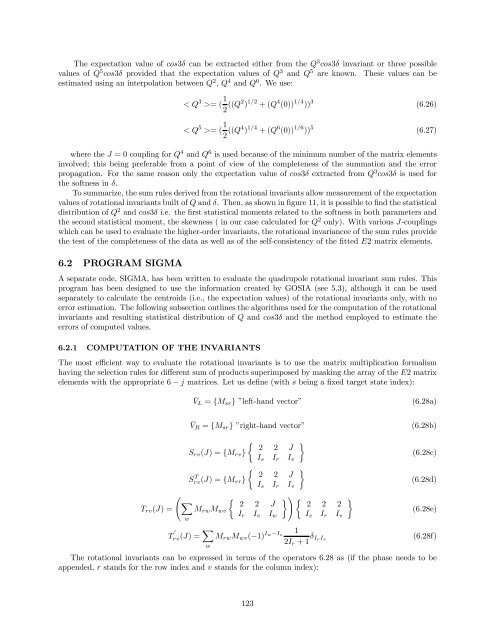coulomb excitation data analysis codes; gosia 2007 - Physics and ...
coulomb excitation data analysis codes; gosia 2007 - Physics and ...
coulomb excitation data analysis codes; gosia 2007 - Physics and ...
Create successful ePaper yourself
Turn your PDF publications into a flip-book with our unique Google optimized e-Paper software.
The expectation value of cos3δ can be extracted either from the Q 3 cos3δ invariant or three possiblevalues of Q 5 cos3δ provided that the expectation values of Q 3 <strong>and</strong> Q 5 are known. These values can beestimated using an interpolation between Q 2 , Q 4 <strong>and</strong> Q 6 .Weuse:=( 1 2 ((Q2 ) 1/2 +(Q 4 (0)) 1/4 )) 3 (6.26)=( 1 2 ((Q4 ) 1/4 +(Q 6 (0)) 1/6 )) 5 (6.27)where the J =0coupling for Q 4 <strong>and</strong> Q 6 is used because of the minimum number of the matrix elementsinvolved; this being preferable from a point of view of the completeness of the summation <strong>and</strong> the errorpropagation. For the same reason only the expectation value of cos3δ extracted from Q 3 cos3δ is used forthe softness in δ.To summarize, the sum rules derived from the rotational invariants allow measurement of the expectationvalues of rotational invariants built of Q <strong>and</strong> δ. Then, as shown in figure 11, it is possible to find the statisticaldistribution of Q 2 <strong>and</strong> cos3δ i.e. the first statistical moments related to the softness in both parameters <strong>and</strong>the second statistical moment, the skewness ( in our case calculated for Q 2 only). With various J-couplingswhich can be used to evaluate the higher-order invariants, the rotational invariancee of the sum rules providethe test of the completeness of the <strong>data</strong> as well as of the self-consistency of the fitted E2 matrix elements.6.2 PROGRAM SIGMAA separate code, SIGMA, has been written to evaluate the quadrupole rotational invariant sum rules. Thisprogram has been designed to use the information created by GOSIA (see 5.3), although it can be usedseparately to calculate the centroids (i.e., the expectation values) of the rotational invariants only, with noerror estimation. The following subsection outlines the algorithms used for the computation of the rotationalinvariants <strong>and</strong> resulting statistical distribution of Q <strong>and</strong> cos3δ <strong>and</strong> the method employed to estimate theerrors of computed values.6.2.1 COMPUTATION OF THE INVARIANTSThe most efficient way to evaluate the rotational invariants is to use the matrix multiplication formalismhaving the selection rules for different sum of products superimposed by masking the array of the E2 matrixelements with the appropriate 6 − j matrices. Let us define (with s being a fixed target state index):¯V L = {M sr } ”left-h<strong>and</strong> vector”(6.28a)Ã XT rv (J) =w¯V R = {M sr } ”right-h<strong>and</strong> vector”½ ¾2 2 JS rv (J) ={M rv }I s I r I v½ ¾Srv(J) T 2 2 J={M vr }I s I r I v½ ¾ ! ½ ¾2 2 J 2 2 2M rw M wvI r I v I w I s I r I v(6.28b)(6.28c)(6.28d)(6.28e)T 0 rv(J) = X wM rw M wv (−1) I w−I s12I r +1 δ I rI v(6.28f)The rotational invariants can be expressed in terms of the operators 6.28 as (if the phase needs to beappended, r st<strong>and</strong>s for the row index <strong>and</strong> v st<strong>and</strong>s for the column index):123
















